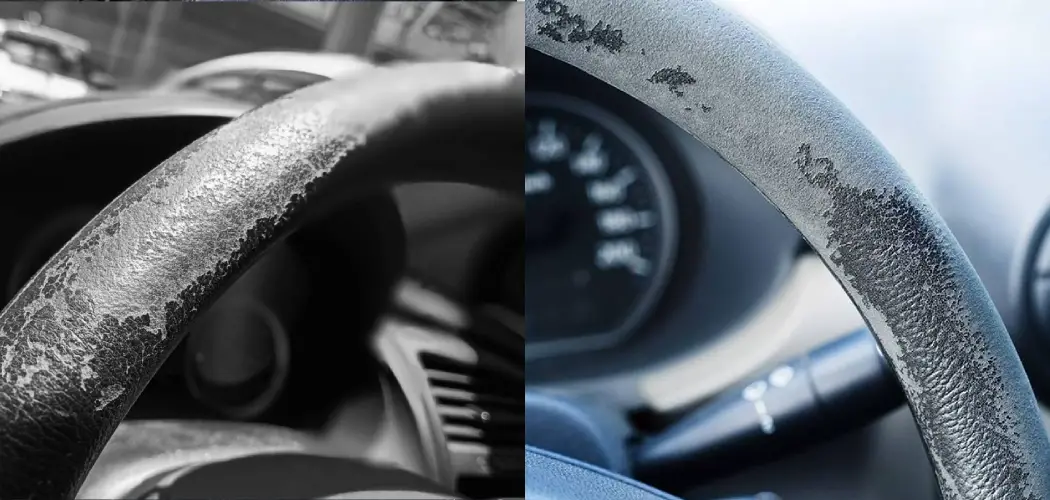Do you have a leather steering wheel that’s seen better days? Maybe it’s dry, cracked, or even starting to peel. Fear not – with a few simple steps; you can restore your steering wheel to its former glory! In this blog post, we’ll show you how to restore steering wheel leather. So read on and get started!
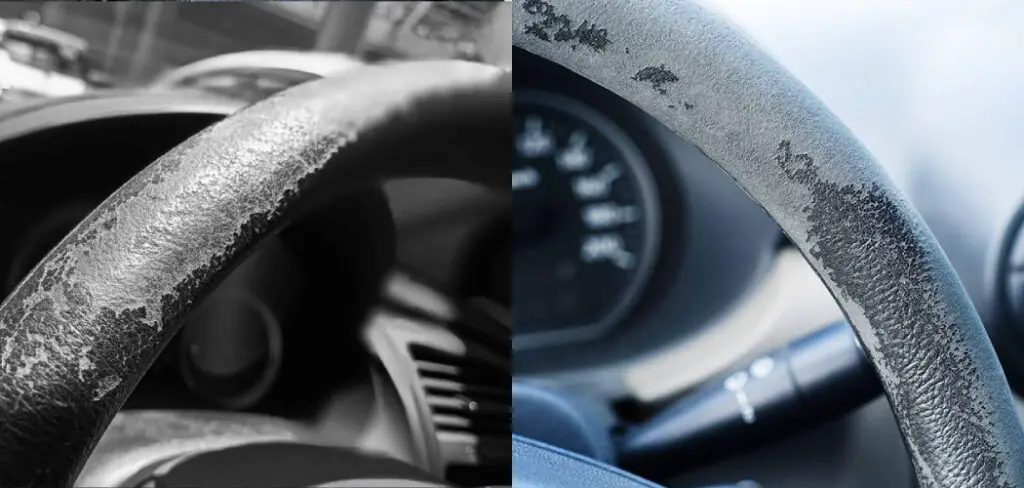
What Is Steering Wheel Leather?
Steering wheel leather is a specially treated form of leather that is used to cover the steering wheels of automobiles. Automakers first began using steering wheel leather in the early 20th century as a way to add a touch of luxury to their vehicles. Today, steering wheel leather is still seen as a sign of quality, and it is often used in high-end automobiles.
In addition to its aesthetic appeal, steering wheel leather is also prized for its durability and comfort. The leather can withstand the rigors of daily use and provides a comfortable grip for drivers. Steering wheel leather is typically available in various colors, allowing car owners to choose the hue that best suits their taste.
Why Should You Restore Steering Wheel Leather?
Over time, the leather on your steering wheel can become worn and cracked, making it less comfortable to grip and impacting the overall look of your car’s interior. While you could replace the entire steering wheel, this can be quite expensive. A much more economical option is to have the leather restored. Here are a few reasons to consider this option:
Restoring the leather on your steering wheel will help to protect it from further damage. The process involves stripping away the old, damaged layer of leather and replacing it with a new one. This will not only improve the appearance of your steering wheel, but it will also help to extend its lifespan.
In addition to protecting your steering wheel, restoring its leather can also improve its grip. This is especially beneficial if you live in an area with cold winters, as the extra grip can help you control your car on icy roads.
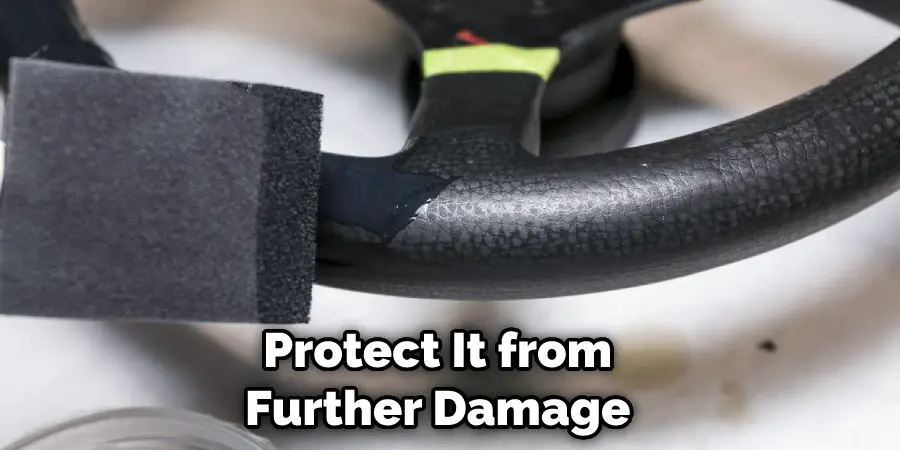
Finally, restoring the leather on your steering wheel can give your car’s interior a new look. If you’re planning to sell your car, this can be a great way to increase its value. Even if you’re not planning to sell, a new-looking interior can make your car feel like new again.
Whether you’re concerned about protecting your investment or simply want to refresh your car’s interior, restoring the leather on your steering wheel is a great option to consider.
8 Steps to Follow on How to Restore Steering Wheel Leather
Step 1: Prep the Steering Wheel
Before you start the process of restoring your steering wheel’s leather, you need to prep the area. This means cleaning the steering wheel to remove any dirt, grime, or residue that could hinder the restoration process. To clean your steering wheel, use a mild soap and water solution. Avoid using harsh chemicals or detergents, as these could damage the leather. Once you’ve prepped the steering wheel, you’re ready to start restoring it.
Step 2: Choose Your Leather Cleaner
There are a variety of leather cleaners on the market, so it’s important to choose one that’s right for your steering wheel. Avoid using harsh chemicals or abrasive cleaners, as these could damage the leather. Instead, opt for a cleaner that’s specifically designed for use on leather surfaces.

Step 3: Apply the Cleaner to the Steering Wheel
Once you’ve chosen a cleaner, it’s time to apply it to the steering wheel. Use a clean cloth or sponge to massage the cleaner into the leather in a circular motion. Be sure to cover the entire surface of the steering wheel.
Step 4: Rinse the Steering Wheel
Once you’ve applied the cleaner, it’s time to rinse it off. Use a clean cloth or sponge and warm water to remove the cleaner from the steering wheel. Be sure to rinse thoroughly until all traces of the cleaner are gone.
Step 5: Dry the Steering Wheel
After you’ve rinsed the steering wheel, it’s important to dry it completely. First, use a clean towel to pat the steering wheel dry. Avoid rubbing the towel over the surface, as this could damage the leather. Once the steering wheel is dry, you’re ready to move on to the next step.
Step 6: Choose Your Leather Conditioner
Just like there are a variety of leather cleaners on the market, there are also a variety of leather conditioners. Choosing a conditioner that’s right for your steering wheel is important. Avoid using harsh chemicals or abrasive conditioners, as these could damage the leather. Instead, opt for a conditioner that’s specifically designed for use on leather surfaces.
Step 7: Apply the Conditioner to the Steering Wheel

Once you’ve chosen a conditioner, it’s time to apply it to the steering wheel. Use a clean cloth or sponge to massage the conditioner into the leather in a circular motion. Be sure to cover the entire surface of the steering wheel.
Step 8: Buff the Steering Wheel
After you’ve applied the conditioner, it’s time to buff the steering wheel. First, use a clean, dry towel to buff the steering wheel in a circular motion. This will help to restore the shine and luster of the leather. Once you’ve buffed the steering wheel, you’re finished! Your steering wheel’s leather should be restored and look like new.
That’s it! You’ve now learned how to restore steering wheel leather. By following these simple steps, you can keep your steering wheel looking like new for years to come.
You Can Visit to Fix Peeling Steering Wheel
How to Choose the Right Restoration Product for Your Vehicle’s Steering Wheel
When it comes to restoring the steering wheel in your vehicle, you want to make sure you choose a product that will do the job right. There are a few things you should keep in mind when making your selection. First, consider the type of material your steering wheel is made of. If it is leather, you will need a different product than if it is vinyl.
Second, think about the extent of the damage. For example, if the steering wheel is only lightly stained, you may be able to get away with a less powerful cleaner. However, if the steering wheel is deeply cracked or discolored, you will need a stronger product that can penetrate into the material’s pores. Finally, consider your budget. Various products are on the market, ranging from inexpensive cleaners to more expensive restoration kits.
By keeping these factors in mind, you can be sure to choose the right product for your needs and get your steering wheel looking like new again. Keep reading for more information about how to restore steering wheel leather.
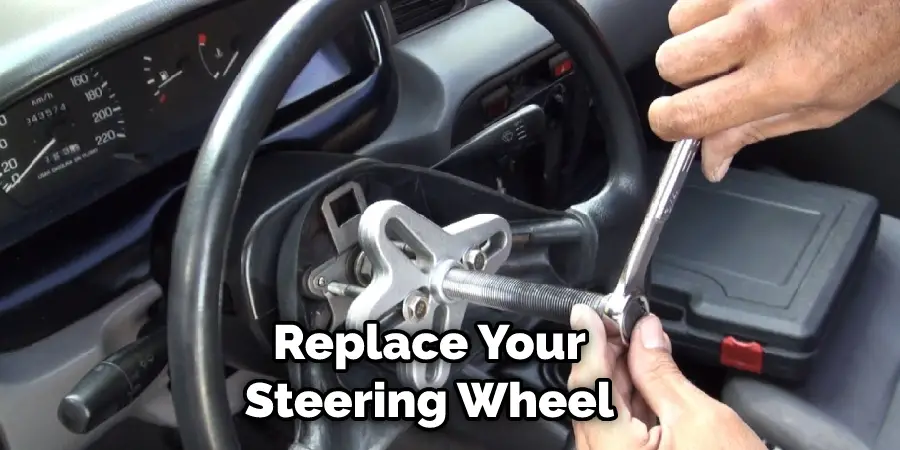
How to Clean and Restore Your Steering Wheel Leather
Over time, leather can become dry and cracked, causing it to lose its original luster. Fortunately, you can take a few simple steps to clean and restore your steering wheel leather. Begin by removing any debris or dirt from the surface of the leather. Next, use a soft cloth to apply a small amount of saddle soap or leather conditioner.
Gently rub the soap into the Leather in a circular motion until it is evenly distributed. Allow the soap to sit on the Leather for a few minutes before wiping it off with a damp cloth. Finally, use a clean, dry cloth to buff the leather until it shines. With just a little bit of care and effort, you can keep your steering wheel looking like new for years to come.
How to Condition Your Steering Wheel Leather
Your steering wheel is one part of your car that you touch every time you drive. Unfortunately, over time, the leather on your steering wheel can start to crack and look dry, which is unsightly and uncomfortable to hold. Thankfully, there are a few easy steps you can follow to condition your steering wheel leather and keep it looking like new. First, clean the steering wheel by wiping it down with a damp cloth.
Next, apply a small amount of leather conditioner to a soft cloth and rub it into the steering wheel in a circular motion. Be sure to avoid getting any conditioner in the surrounding area, such as the dashboard or upholstery. Once the conditioner has been fully absorbed, buff the steering wheel with a clean cloth to remove any excess. These simple steps will help keep your steering wheel looking great for years to come.
How to Fix a Peeling Steering Wheel Leather
Peeling leather on a steering wheel can be unsightly and may even affect how well the driver can grip the wheel. Many steering wheels are made of synthetic leather that is designed to withstand years of wear and tear, but even this material can eventually succumb to the elements. If you find yourself in this predicament, don’t despair – there are a few easy ways to fix a peeling steering wheel leather.
The first step is to clean the surface of the steering wheel using a mild soap and water solution. Once the surface is clean, let it dry completely before moving on to the next step. The next step is to apply a thin layer of adhesive to the back of the patch or piece of leather you will be used to cover the peeled area. Be sure to use an adhesive that is specifically designed for use with synthetic leather.
Once the adhesive has been applied, press the patch or piece of leather into place and allow it to dry completely. This process may need to be repeated if the leather continues to peel. However, with some patience and basic supplies, you can easily fix a peeling steering wheel leather and restore your car’s interior to its former glory.
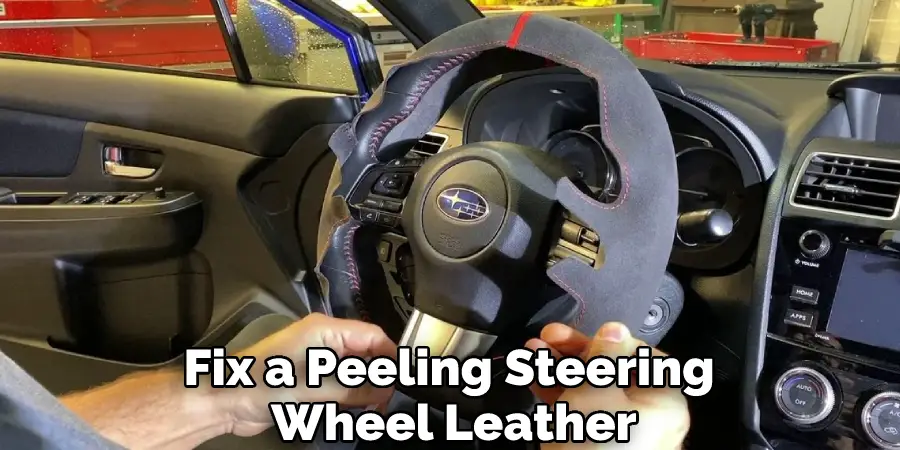
Frequently Asked Questions
Can You Fix a Damaged Leather Steering Wheel?
It depends on the severity of the damage. However, some common repairs that can be made to leather steering wheels include sewing them back together or replacing the entire wheel. If the damage is more extensive, such as a tear in the leather, then a new wheel may be necessary.
Are Leather Steering Wheels Real Leather?
Leather steering wheels are made from real leather, but there is a thin layer of plastic or resin on top that provides protection and prevents the leather from deteriorating. This layer of plastic or resin is usually renewed or replaced every few years, as the leather gradually wears away and the plastic begins to peel away.
Why is My Leather Steering Wheel Fading?
Leather steering wheels tend to fade over time because they are exposed to sunlight and air. The sun’s ultraviolet (UV) radiation breaks down the natural compounds in the leather, which then causes the leather to fade and lose its color. The air also causes the leather to oxidize and turn brown, which can also lead to fading. To prevent your leather steering wheel from fading, keep it covered when not in use and avoid exposing it to direct sunlight or air. If your steering wheel is already faded or has lost its color, you may be able to restore it by treating it with a leather conditioning product.
Is Peeling Leather Repairable?
Yes, peeling leather can be repaired if the damage is minor and the leather is still in good condition. To repair a small tear or hole in peeling leather, use a patch kit or adhesive to fix the tear or hole. Be sure to test the adhesive first on a small area of the leather to make sure it will hold before applying it to the entire piece. If the damage is more extensive, you may need to replace the entire piece of leather. In either case, be sure to use a waterproof sealant to protect the new leather from moisture and UV rays.
Conclusion
When restoring steering wheel leather, you can try a few different methods. Which one you choose will depend on the severity of the damage and how much time and effort you want to put into it. Hopefully, this article has given you a good starting point for repairing your own steering wheel leather. Thanks for reading our post about how to restore steering wheel leather. Have any tips or tricks of your own? Let us know in the comments below!

